Sep 19, 2011
La Nina’s Reprise has important implications globally
Weatherbell Meteorologists Joe Bastardi and Joe D’Aleo
Since the inception of Weatherbell last winter, we warned the ‘super’ La Nina of 2010/11 would have major implications. We focused correctly weeks to months in advance on the potential of strong tornado outbreaks, devastating flooding from late snowmelt and heavy rain in the central states, growing drought and heat in Texas and an impact hurricane season with east coast and Gulf coast landfalls likely.
Weatherbell also predicted that the La Nina would weaken into this summer but return for a second winter. This was based on a cold Pacific Decadal Oscillation which usually means La Ninas last two years or more. NOAA came onboard to this thinking in making the La Nina return official in August.
Weatherbell sees the impact of this return La Nina will be again global in nature and significant. Another harsh winter is expected in China and at least the first half of the winter in North America and Western Europe. More heavy snow will accompany the cold as our outlook will show next week
With widespread cooling, WeatherBell Analytics Meteorologists Joe Bastardi and Joe D’Aleo are predicting the global temperature, which has average near 0.2C above normal this year after being over 0.4C above normal last year, will drop to near -0.15C BELOW by March. This is similar to what we saw in 2008. This will mean the yearly cooling trend, off the warm year of 2010, which is underway now, will continue in 2012, which is liable to be the coolest year since the late 1990s.
Computer modeling is now starting to see this. The JAMSTEC Frontier model captures the cooling for both hemispheres this December to February. Most of that southeast United States warmth would come in late winter.
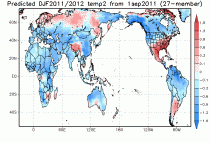
Enlarged
The model shows cooling of the Atlantic to the cold mode, at least temporarily, is likely over the coming 6-9 months following the cooling of the Pacific. The drop is already starting with September. It is likely to be 0.1 to 0.2C cooler than August, which read 0.33C above.
The upcoming ocean cooling can be seen in the same Frontier Model. While there is already the horseshoe of cold water currently surrounding the central Pacific Kuroshio warm plume, which is characteristic of the cold PDO, the model shows the Atlantic will cool and the Atlantic Multidecadal Oscillation will turn negative again as it did in 2008. This will result in a global temperature decline.
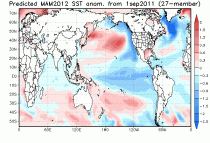
Enlarged
The recent warming in the satellite era can be tied to first the warm PDO and dominance of El Ninos from 1977 to 1998 and then a step warming after 1995 when the Atlantic warm mode ensued. The Pacific has cooled with 7 La Ninas now since 1999 which has flattened the warming. A cooling of the Atlantic would result in a step down global cooling.
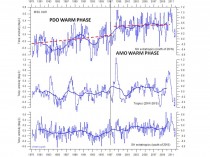
Enlarged
We want to continue to demonstrate to the public that the cyclical events of the global climate and the associated extremes are tied into well established natural causes and importantly PREDICTABLE. As we have with the extreme events of this past year, we trust the forecast of this before the fact, rather than explaining after will make this point once again. The last AMO warm phase lasted about 20 years, so the return to the cold Atlantic and global cooling is likely to occur this decade even if this is another temporary change.
Weatherbell has had a US winter outlook since June 1, which many are now mimicking and the latest NOAA forecast is remarkably similar too. A more detailed outlook will be out September 28, but we are available for worldwide ideas. Also as we have outlooks also for Europe and the far east where major impacts are forecast.
The bottom line is a global temperature drop is coming to the coldest levels in at least several years, and there are winter implications that if you get the jump on, may be of benefit to you
Sep 17, 2011
John O’Sullivan: Fifty IPCC Experts Expose Washington Post Global Warming Lies
Climate Realists

Enlarged.
Mainstream media mouthpiece left shamefaced as fifty international climate experts break ranks to defy global warming cult and denounce junk science.
Washington Post op-ed writer Richard Cohen was last week caught lying while bad mouthing Texas governor, Rick Perry’s presidential candidacy. Cohen, who would have his readers believe humans are dangerously warming the planet, jumped the shark to attack skeptic Perry over his stance on the man-made global warming issue (AGW). Cohen spouted the kooky claim that skeptic scientists “could hold their annual meeting in a phone booth, if there are any left.”
Sadly for Cohen the facts below prove he is just another mendacious mainstream propagandist of climate alarmism.
For instance, the shocking truth is that all 5 official data sets show global cooling since 2002 while a third of all stations sustain a long term cooling trend for their entire history.
Indeed, so infuriated over the blatant lies is Nobel Prize winning physicist, Dr. Ivar Giaever, that last week he resigned in disgust from the American Physics Society for their part in sustaining the now utterly debunked AGW propaganda.
The physics professor who scooped the Nobel Science Prize in 1973 sagely notes, “It is amazing how stable temperature has been over the last 150 years.”
Professor Giaever and the rank and file of scientists are increasingly aware that the ‘consensus’ Cohen and his collaborators alludes to is little more than 77 of 10,000 scientists polled.
Surge in Government Climate Experts Going Skeptic
To further llustrate just how off base Cohen’s spin really is just observe the increasing number of experts who actually worked for the IPCC as contributors / editors / reviewers now turning against global warming junk science. (Hat Tip: The Galileo Movement).
Below, for Cohen and those other mainstream media deniers of climate realism, is a list of just 50 former IPCC experts whose voices your prejudiced ears refuse to hear:
See the 50 responses here.
Sep 15, 2011
Yogi Berra: “It’s deja vu all over again”; Tamino: “No. Your cherry picking… its unprecedented!”
By Steve Goddard
Been There, Done That In The Arctic
Posted on September 18, 2011 by Steven Goddard
Tamino is hopping mad about Joe D’Aleo’s suggestions on WUWT that the Arctic has been this warm in the past, and that ice has melted in the past. The gradual education of Tamino is a worthy - though hopeless cause.
The current Greenland warming, while not yet quite matching the temperatures of 70 years ago
- Walt Meier NSIDC
“Examination of several proxy records (e.g., sediment cores) of sea ice indicate ice-free or near ice-free summer conditions for at least some time during the period of 15,000 to 5,000 years ago”
- Walt Meier NSIDC
CLEVELAND, Feb. 16 (A.A.P.) Dr. William S. Carlson, an Arctic expert, said to-night that the Polar icecaps were melting at an astonishing and unexplained rate and were threatening to swamp seaports by raising the ocean levels.
Leading Arctic expert from 1953
Dr. Ahlman urged the establish- ment of an international agency to study conditions on a global basis. Temperatures had risen 10 degrees since 1900. The navigable season along Western Spitzbergen now lasted eight months instead of three.
Leading Arctic expert from 1947
It was concluded that near Polar temperatures are on an average six degrees higher than those registered by Nansen 40 years ago. Ice measurements were on an average only 6½ feet against from 9¼ to 13 feet.
Russian report from 1940
The Norwegian, Captain Wiktor Arnesen, who has just returned from the Arctic, clains to have discovered an island 12 miles in circumference near the Franz Joseph Island, in latitude 80.40. He says that the island previously was hidden by an iceberg between 70 and 80 feet high, which has melted, showing the exceptional nature of the recent thawing in the Arctic.
See many more stories that demonstrate this has happened before.
---------------
Sea level decline continues
The latest sea level numbers are out, and Envisat shows that the two year long decline is continuing, at a rate of 5mm per year.
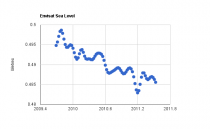
Enlarged
ftp://ftp.aviso.oceanobs.com/
And in the artcic, ice extent from satellite has been increasing now for a week. If the trend up continues (likely unless changing winds moves ice near the edge out to the Atlantic or compresses it), it will have fallen 6.4% short of 2007’s satellite age record.
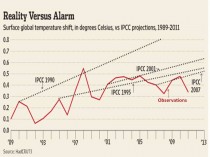
enlarged.
The following shows in green the ice this year that was not there in 2007, the red in 2007 areas with ice that have less than 15% cover on this date (enlarged).

See how natural factors explains the decline and how the ice has varied in a predictable multidecadal cycle over the last century here.
The snow is beginning to show up in Canada and Siberia (enlarged).
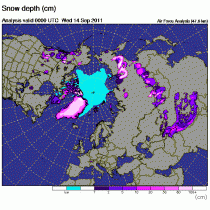
Sep 14, 2011
Nobel Prize-Winning Physicist Who Endorsed Obama Dissents! Resigns from American Physical Society
Climate Depot Exclusive
Unlike Gore, the IPCC and Krugman, a deserving Nobelist speaks out. See also this IBD editorial.
Nobel prize winner for physics in 1973 Dr. Ivar Giaever resigned as a Fellow from the American Physical Society (APS) on September 13, 2011 in disgust over the group’s promotion of man-made global warming fears. Climate Depot has obtained the exclusive email Giaever sent titled “I resign from APS” to APS Executive Officer Kate Kirby to announce his formal resignation.
Dr. Giaever wrote to Kirby of APS: “Thank you for your letter inquiring about my membership. I did not renew it because I cannot live with the (APS) statement below (on global warming): APS: ‘The evidence is incontrovertible: Global warming is occurring. If no mitigating actions are taken, significant disruptions in the Earth’s physical and ecological systems, social systems, security and human health are likely to occur. We must reduce emissions of greenhouse gases beginning now.’
Giaever announced his resignation from APS was due to the group’s belief in man-made global warming fears. Giaever explained in his email to APS: “In the APS it is ok to discuss whether the mass of the proton changes over time and how a multi-universe behaves, but the evidence of global warming is incontrovertible? The claim (how can you measure the average temperature of the whole earth for a whole year?) is that the temperature has changed from 288.0 to 288.8 degree Kelvin in about 150 years, which (if true) means to me is that the temperature has been amazingly stable, and both human health and happiness have definitely improved in this ‘warming’ period.”
Giaever was one of President Obama’s key scientific supporters in 2008. Giaever joined over 70 Nobel Science Laureates in endorse Obama in an October 29, 2008 open letter. In addition to Giaever, other prominent scientists have resigned from APS over its stance on man-made global warming. See: Prominent Physicist Hal Lewis Resigns from APS: ‘Climategate was a fraud on a scale I have never seen...Effect on APS position: None. None at all. This is not science’
Giaever, a professor at the School of Engineering and School of Science Rensselaer Polytechnic Institute, has become a vocal dissenter from the alleged “consensus” regarding man-made climate fears. He was featured prominently in the 2009 U.S. Senate Report of (then) Over 700 Dissenting International Scientists from Man-made global warming. Giaever, who is a member of the National Academy of Sciences and won the 1973 Nobel Prize for Physics.
Giaever was also one of more than 100 co-signers in a March 30, 2009 letter to President Obama that was critical of his stance on global warming. See: More than 100 scientists rebuke Obama as ‘simply incorrect’ on global warming: ‘We, the undersigned scientists, maintain that the case for alarm regarding climate change is grossly overstated’
Giaever is featured on page 89 of the 321 page of Climate Depot’s more than 1000 dissenting scientist report (updated from U.S. Senate Report). Dr. Giaever was quoted declaring himself a man-made global warming dissenter. “I am a skeptic...Global warming has become a new religion,” Giaever declared. ‘I am Norwegian, should I really worry about a little bit of warming? I am unfortunately becoming an old man. We have heard many similar warnings about the acid rain 30 years ago and the ozone hole 10 years ago or deforestation but the humanity is still around,” Giaever explained. “Global warming has become a new religion. We frequently hear about the number of scientists who support it. But the number is not important: only whether they are correct is important. We don’t really know what the actual effect on the global temperature is. There are better ways to spend the money,” he concluded.
Giaever also told the New York Times in 2010 that global warming “can’t be discussed—just like religion...there is NO unusual rise in the ocean level, so what where and what is the big problem?”
This is not the first climate induced headache for the American Physical Society. It’s strict adherence to man-made global warming beliefs has created a stir in the scientific community and let to an open revolt of its scientific members.
On May 1, 2009, the American Physical Society (APS) Council decided to review its current climate statement via a high-level subcommittee of respected senior scientists. The decision was prompted after a group of over 80 prominent physicists petitioned the APS revise its global warming position and more than 250 scientists urged a change in the group’s climate statement in 2010. The physicists wrote to APS governing board: “Measured or reconstructed temperature records indicate that 20th - 21st century changes are neither exceptional nor persistent, and the historical and geological records show many periods warmer than today.” An American Physical Society editor conceded that a “considerable presence” of scientific skeptics exists.
In October 2010, the APS suffered more scientific woes when another one of its prominent physicists resigned. The late Physicist Hal Lewis, who died in May of 2011, excoriated the APS leadership for its strict dogmatic like adherence to man-made global warming beliefs. See: Prominent Physicist Resigns: ‘Climategate was a fraud on a scale I have never seen...Effect on APS position: None. None at all. This is not science’ & See: Prominent Physicist Resigns From American Physical Society: ‘Global warming is the greatest and most successful pseudoscientific fraud I have seen in my long life’—APS President Curtis Callan ‘seems to have abandoned most ethical principles...APS has become a corrupt organization’ & see: APS responds to resignation of Dr. Hal Lewis—AND Dr. Lewis Responds Back To APS!
APS President has been under fire as well. See: ‘APS President Callan didn’t even bother to discuss the ClimateGate and the petition inspired by it with Will Happer and Robert Austin’
Below is the full text of Dr. Ivar Giaever’s full letter of resignation to the APS:
From: Ivar Giaever [ mailto:giaever@XXXX.com]
Sent: Tuesday, September 13, 2011 3:42 PM
To: kirby@aps.org
Cc: Robert H. Austin; ‘William Happer’; ‘Larry Gould’; ‘S. Fred Singer’; Roger Cohen
Subject: I resign from APS
Dear Ms. Kirby
Thank you for your letter inquiring about my membership. I did not renew it because I can not live with the statement below:
Emissions of greenhouse gases from human activities are changing the atmosphere in ways that affect the Earth’s climate. Greenhouse gases include carbon dioxide as well as methane, nitrous oxide and other gases. They are emitted from fossil fuel combustion and a range of industrial and agricultural processes.
The evidence is incontrovertible: Global warming is occurring.
If no mitigating actions are taken, significant disruptions in the Earth’s physical and ecological systems, social systems, security and human health are likely to occur. We must reduce emissions of greenhouse gases beginning now.
In the APS it is ok to discuss whether the mass of the proton changes over time and how a multi-universe behaves, but the evidence of global warming is incontrovertible? The claim (how can you measure the average temperature of the whole earth for a whole year?) is that the temperature has changed fro288.0 to ~288.8 degree Kelvin in about 150 years, which (if true) means to me is that the temperature has been amazingly stable, and both human health and happiness have definitely improved in this ‘warming’ period.
Best regards,
Ivar Giaever
Nobel Laureate 1973
PS. I included a copy to a few people in case they feel like using the information.
Sep 14, 2011
Skinning The Cat With Climate Justice
By Meteorologist Art Horn, Icecap, in the Energy Tribune
In early November of 2010 President Obama’s attempt to pass a bill that would bring a Cap-and-Trade system to the United States to control emissions of carbon dioxide failed. After this defeat he proclaimed “Cap-and-Trade was just one way of skinning the cat, it was a means not and end. I’m going to be looking for other means to address this problem” He has found that means, it’s called climate justice. Actually he had it in his back pocket all the time.
Never heard of climate justice? It’s been around for about 20 years. It was given life by President Clinton on February 11th 1994 with executive order 12898. It required no less than 11 federal agencies to “make achieving environmental justice part of its mission by identifying and addressing, as appropriate, disproportionately high and adverse human health or environmental effects of its programs, policies, and activities on minority populations and low-income populations.”
By now you must be asking what is climate justice? The organization Mobilization for Climate Justice defines it as “a vision to dissolve and alleviate the unequal burdens created by climate change. As a form of environmental justice, climate justice is the fair treatment of all people and freedom from discrimination with the creation of policies and projects that address climate change and the systems that create climate change and perpetuate discrimination.”
So the idea is to make the adverse effects of global warming (climate change) a moral issue. It infers that anyone, any government or government policy, or any company that in any way produces something that causes global warming and therefore climate change is discriminating against an individual or group that can’t fight back due to their minority status or low-income. It is therefore immoral for any entity to produce anything that causes climate change and that there should be consequences for those actions. Depriving anyone of the right to climate justice is a crime against that person’s right to prosper from a healthy climate, free from man made global warming. To president Obama the founding fathers of this country, many who were slave owners, intended us to have life, liberty and the pursuit of climate justice.
Perhaps the key phrase in the above definition of climate justice is “the creation of policies and projects that address climate change and the systems that create climate change.” One of those “systems” that create climate change would be the way we make energy through the use of fossil fuels. Climate justice proclaims that using fossil fuels to make energy is causing the earth’s temperature to rise and that doing so is therefore immoral. Those “systems” that allegedly cause climate change include the oil companies and utilities that generate electricity along with anything else that produces carbon dioxide such as you and I.
The goal of climate justice is to stop the world from using fossil fuels to make energy because it is immoral and discriminatory. This is the blade that President Obama hopes to use to skin the cat. By issuing a memorandum of understanding on environmental justice and executive order number 12898 in August of this year, President Obama hopes to develop policies that will empower people who are discriminated against by those polluting entities that are creating climate change. That is the way around his Cap-and-Trade defeat. He said “I’m going to be looking for other means to address this problem”.
The potential destructive power of this policy can’t be underestimated, especially if he is re-elected. Armed with this “moral” weapon the president and his supporters will be able to go after all energy companies that use fossil fuels. One of his most powerful allies in this endeavor is Lisa Jackson, Chief of the EPA. Jackson is an ardent climate justice proponent. She has been a leader in the fight to legitimize the concept of climate justice. There is even a climate justice website within the EPA! Jackson is quoted as saying “We want to put and end to the days when public health and economic potential are harmed by disproportionate exposure to pollution.” The word “pollution” is code for carbon dioxide.
Climate justice is deeply rooted in the policies and ideologies of the United Nations. In 2000 the first Climate Justice Summit took place at The Hague, the Netherlands along side the 6th Conference of Parties (COP6) of the United Nations Framework Convention on Climate Change. The Climate Summit proclaimed “We affirm that climate change is a rights issue. It affects our livelihoods, our health, our children and our natural resources. We will build alliances across states and boarders to oppose climate change patterns and advocate for and practice of sustainable development.” The words “climate change patterns” are code for any government or company that produces carbon dioxide.
In 2010 the World People’s Conference on Climate Change and the Rights of Mother Earth took place in Tiquipaya, Bolivia. At the conference issues of climate justice were discussed. These discussions resulted in a People’s Agreement calling for the possible formation of an International Climate and Environmental Justice Tribunal. If developed this international environmental court could eventually prosecute companies or whole nations for the crime of endangering climate justice by using fossil fuels to make energy. Though the conference did not advocate the establishment of such a court the objective was “to asses whether an International Climate Justice Tribunal or alternatively an International Environmental Court is necessary or appropriate as a means to enforce commitments to reduce greenhouse gas emissions.” Even thinking of these possibilities should send chills down the back of freedom loving people.
President Obama and his administration are apparently in lock step with the United Nations and its pursuit of climate justice. If implemented as a policy here in the United States, climate justice, as a matter of enforceable law, would introduce uncertainty factors into the energy markets that would dwarf anything we’ve seen so far. The resulting lawsuits against all energy producing companies and the resulting price increases as a result of multi-billion dollar settlements could be catastrophic to a nation that is already teetering on the brink of collapse from overspending and suffocating EPA regulations.
Climate justice has nothing to do with the climate and nothing to do with justice. It is a covert vehicle for socialists to re-invent the way we make energy and to propel the radial environmental movement into a leadership roll in American government. The goal of the advocates of this agenda is to supplant the Constitution of The United States with climate justice and therefore establish radical environmental policies as the rule of the land. Amazingly our own president seems to be moving in this direction. He did say just before the election that “We are days away from fundamentally transforming The United States of America.” Climate justice is part of that transformation and will be the weapon of choice to skin our energy producing companies.
|










